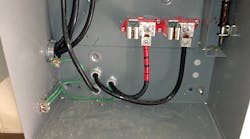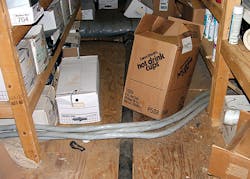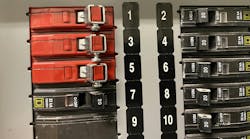How well do you know the Code? Think you can spot violations the original installer either ignored or couldn’t identify? Here’s your chance to moonlight as an electrical inspector and second-guess someone else’s work from the safety of your living room or office. Can you identify the specific Code violation(s) in this photo? Note: Submitted comments must include specific references from the 2014 NEC.
Hint: Phase to face
Tell Them What They Have Won...
Using the 2014 NEC, correctly identify the Code violation(s) in this month’s photo — in 200 words or less — and you could win an Arlington Industries TVL508 Low Profile TV BOX. E-mail your response, including your name and mailing address, to [email protected], and Russ will select three winners (excluding manufacturers and prior winners) at random from the correct submissions. Note that submissions without an address will not be eligible to win.
JUNE WINNERS
Our three winners this month were: Felix Arroyo, a third year apprentice with Cox Electric in Seffner, Fla.; Joseph Lombardi, a journeyman electrician at Local 3 IBEW in Oakland Gardens, N.Y.; and Milton E. Curtis, a master electrician in South Dennis, Mass. Each one of them was able to correctly identify the Code violations shown in this attic space.
Section 338.10(B)(4)(a) requires SE cables to comply with Part II of Art. 334 when installed indoors. Section 334.23 sends us to 320.23 when these cables are installed in an accessible attic. Where run on top of floor joists or within 7 ft of the floor, this section of the Code requires these cables to be protected by suitable guard strips that are at least as high as the cable. Where run exposed, 334.15 also requires these cables to be protected from physical damage “where necessary.” This protection can be in the form of RMC, IMC, EMT, Schedule 80 PVC, RTRC-XW type, or other approved means. Section 338.12(A)(1) also requires some form of protection for the cables where subject to physical damage. In this case, I truly believe some protection is necessary. These cables are in harm’s way because this area is used for storage, and they could easily be stepped on or damaged by falling storage items.






